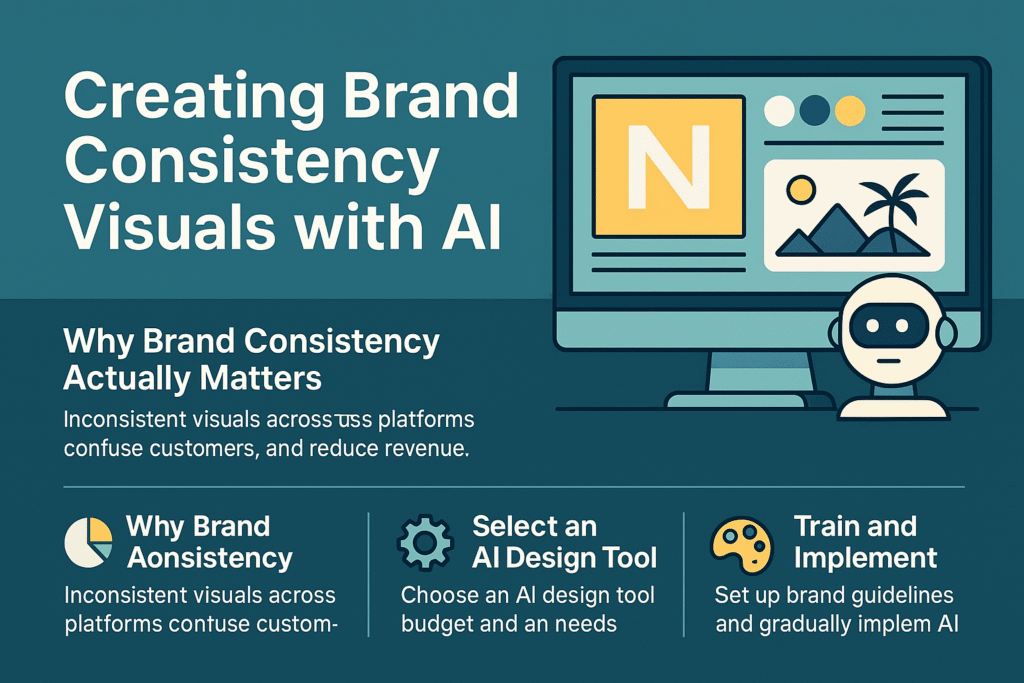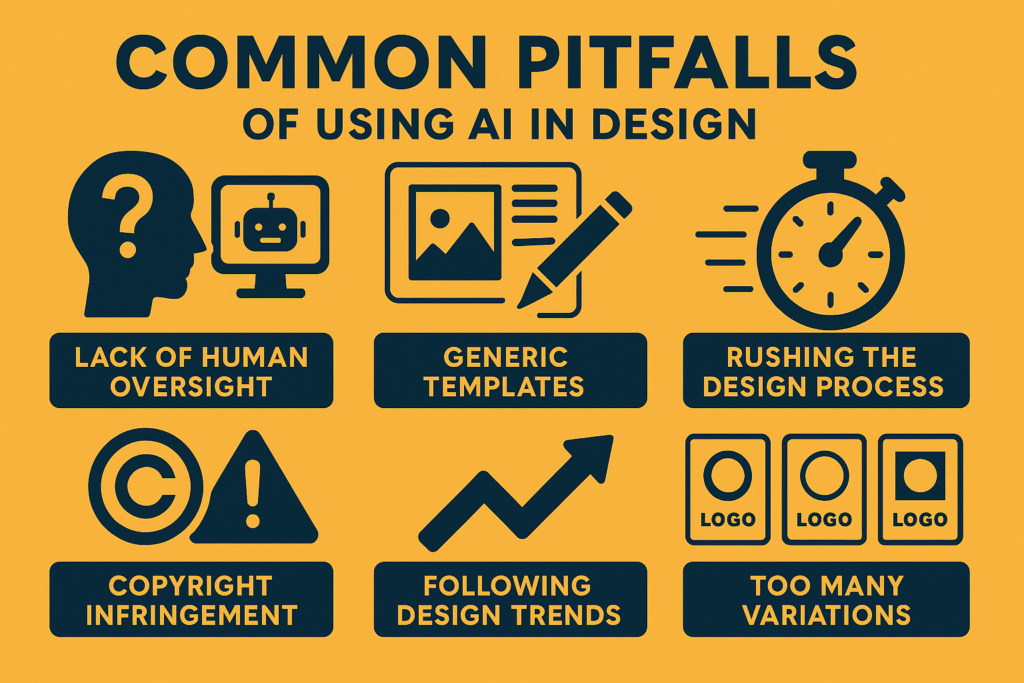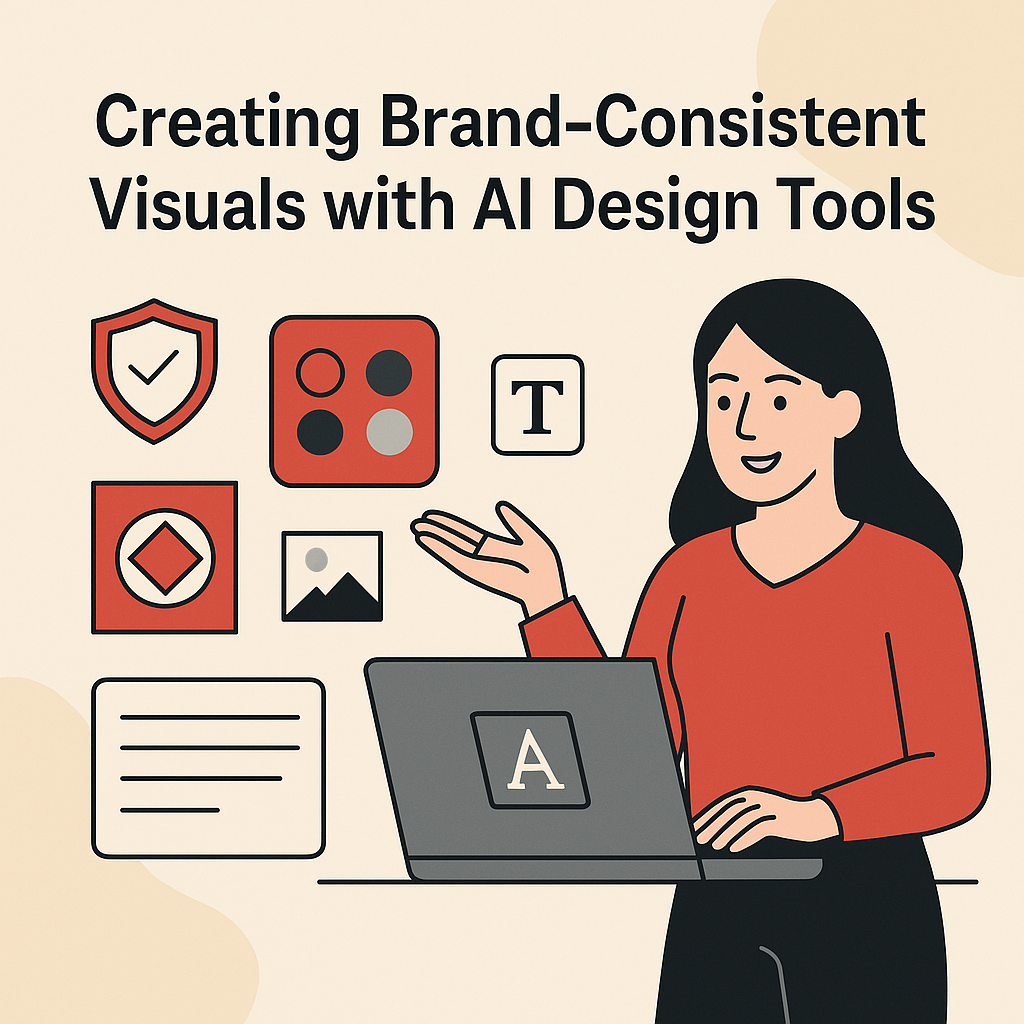Table of Contents
Creating brand consistent visuals with AI has changed how businesses handle their visual identity across platforms. Picture this: you’re scrambling to create graphics for next week’s campaign, but everything looks different from your last posts. Sound familiar?
Most business owners face this exact problem. They need fresh content constantly, but can’t afford a design team. The result? Visuals that don’t match, confusing customers and weakening brand recognition.
Here’s the thing – AI design tools have shifted the game completely. These platforms help you create professional, brand-aligned designs in minutes instead of hours. Let’s explore how you can use these tools to build a stronger visual presence without spending a fortune.

Why Brand Consistency Actually Matters
The Financial Impact of Consistent Brand Visuals
Your brand visuals often make the first impression on potential customers. Research shows that consistent brand presentation can boost revenue by up to 33%. Yet many small businesses struggle with maintaining this consistency across different marketing channels.
Think about it – when you see a company’s social media post that looks nothing like their website, does it feel professional? Probably not. This disconnect happens when businesses lack clear visual guidelines or the right tools to implement them.
Building Trust Through Visual Consistency
Brand consistency builds trust. When customers see the same colors, fonts, and design elements everywhere, they develop confidence in your professionalism. This trust directly translates into sales and customer loyalty.Building a strong, awesome brand will help you establish the foundation these AI tools need to work effectively
Consider some of the most successful brands you know. Apple, McDonald’s, or Coca-Cola – you can spot their materials from across the room. That’s not an accident. These companies invest heavily in maintaining visual consistency because they understand its power.
The Psychology of Brand Recognition
The psychology behind brand recognition is simple. Our brains process visual information faster than text. When customers see consistent brand visuals, they quickly identify your business and associate it with their previous experiences. This recognition breeds familiarity, and familiarity breeds trust.
Understanding AI Design Tools for Brand Visuals
How AI Design Tools Learn Your Brand
AI design tools have evolved way beyond basic template generators. Modern platforms use machine learning to understand your brand preferences and create designs that match your style automatically. These tools analyze your existing visuals and learn your brand’s unique characteristics.
The best AI design platforms offer features like brand kit integration, automatic color palette generation, and style transfer capabilities. They can take your logo and brand colors and apply them consistently across hundreds of different design formats.
Popular AI Design Platforms
Popular AI design tools include Canva’s AI features, Adobe’s Creative Suite with AI integration, and specialized platforms like Looka and Brandmark. Each offers different strengths depending on your specific needs and budget.
What makes these tools particularly valuable is their ability to maintain brand consistency without constant human oversight. Once you’ve trained the AI on your brand preferences, it can generate designs that align with your style guidelines automatically. This saves countless hours that would otherwise be spent on manual design work.
The Learning Curve for AI Design Tools
The learning curve for most AI design tools is surprisingly gentle. You don’t need advanced design skills to create professional-looking visuals. The AI handles the technical aspects while you focus on your message and brand strategy.
Setting Up Your Brand Foundation
Essential Brand Elements for AI Tools
Before jumping into AI design creation, you need a solid brand foundation. This means having clear brand guidelines that include your logo variations, color palette, typography choices, and visual style preferences.
Start by documenting your primary and secondary colors with exact hex codes. AI tools work best when they have precise color information to work with. Include at least 3-5 colors that represent your brand effectively.
Typography and Font Selection
Your typography choices matter just as much. Select 2-3 fonts that work well together – one for headlines, one for body text, and optionally one for accents. Many AI tools can access extensive font libraries, so choose fonts that are widely available.
Define your visual style clearly. Are you modern and minimalist, or warm and approachable? Do you prefer photography or illustrations? These preferences will guide the AI in making design decisions that align with your brand personality.
Creating Visual References
Creating a mood board can help clarify your visual direction. Collect images, colors, and designs that represent your brand’s feel. This visual reference becomes invaluable when setting up AI design tools and training them on your preferences.
Don’t forget about your brand’s voice and personality. Are you playful or serious? Professional or casual? These characteristics should influence your visual choices and help the AI create designs that match your overall brand message.
Using AI for Logo and Brand Mark Creation
AI logo generators have become surprisingly sophisticated. Tools like Looka and LogoMaker can create professional logos based on your industry, style preferences, and color choices. The trick is providing detailed input about your brand personality and target audience.
When using AI for logo creation, start with multiple concepts. Generate 10-20 variations and then refine the most promising options. Most AI tools allow you to iterate on designs by adjusting colors, fonts, and layouts until you find the perfect match.
Don’t expect perfection on the first try. AI-generated logos often need human refinement to truly capture your brand essence. Use the AI output as a starting point, then work with a designer to polish the final version.
Consider creating a full brand mark system, not just a single logo. This includes horizontal and vertical layouts, simplified versions for small applications, and variations for different backgrounds. AI tools can help generate these variations once you have your primary logo established.
Automating Social Media Graphics
Setting Up Social Media Templates
Social media demands constant visual content, making it perfect for AI design tools. Platforms like Buffer and Hootsuite now include AI-powered design features that can create on-brand posts automatically.
Set up templates for your most common social media formats. This includes Instagram posts, Stories, Facebook covers, and LinkedIn graphics. AI tools can then populate these templates with your content while maintaining brand consistency.
A/B Testing with AI-Generated Visuals
Use AI to generate multiple versions of the same message. This works particularly well for A/B testing different visual approaches while keeping your brand elements consistent. The AI can vary layouts, color emphasis, and imagery while preserving your core brand identity.
Batch Creation for Efficiency
Batch creation is another powerful feature. Upload your brand assets once, then generate dozens of social media graphics in minutes. This approach ensures consistency while dramatically reducing the time spent on routine design tasks.
Creating Consistent Marketing Materials
AI design tools excel at creating marketing materials that follow your brand guidelines automatically. From business cards to brochures, these tools can maintain consistency across all your print and digital materials.
Start with your most frequently used materials. Business cards, letterheads, and email signatures are foundational pieces that should reflect your brand perfectly. AI tools can generate these quickly while ensuring proper spacing, typography, and color usage.
For more complex materials like brochures and presentations, use AI to create initial layouts and then customize the content. This approach gives you professional-looking designs without starting from scratch each time.
Consider creating a library of AI-generated templates for different purposes. Having pre-made templates for product announcements, event promotions, and general marketing messages speeds up your workflow significantly.
Maintaining Design Consistency Across Platforms
Different platforms have different requirements, but your brand should remain recognizable everywhere. AI tools can help you adapt your designs for various platforms while maintaining core brand elements.
Create platform-specific brand guidelines that account for different aspect ratios, text sizes, and visibility requirements. For example, designs for mobile need larger text and simpler layouts than desktop versions.
Use AI to automatically resize and reformat your designs for different platforms. Many tools can take a single design and generate versions optimized for Instagram, Facebook, Twitter, and LinkedIn simultaneously.
Test your designs across different devices and platforms before finalizing them. What looks great on a desktop might not work on mobile. AI tools can help you preview and adjust designs for optimal visibility across all platforms.
Measuring and Improving Your Visual Impact
Track the performance of your AI-generated visuals to understand what works best for your audience. Most social media platforms provide analytics that show how your visuals perform compared to text-only posts.
Pay attention to engagement rates, click-through rates, and conversion metrics. Visuals that perform well share common characteristics that you can incorporate into future AI-generated designs.
Use A/B testing to compare different visual approaches. Create multiple versions of the same message with different layouts, colors, or imagery. This data helps train both you and the AI tools to make better design decisions.
Gather feedback from your audience through surveys or social media comments. Understanding how your visuals are perceived helps you refine your brand guidelines and improve future AI-generated content.
Advanced AI Design Techniques
As you become more comfortable with AI design tools, explore advanced features that can elevate your brand visuals. Style transfer allows you to apply the visual style of one image to another, creating unique branded content.
Experiment with AI-generated photography and illustrations. Tools like Midjourney and DALL-E can create custom visuals that perfectly match your brand style. This eliminates the need for expensive stock photography while ensuring uniqueness.
Use AI for color palette generation based on your industry or target audience emotions. These tools can suggest colors that evoke specific feelings or associations, helping you make more strategic design decisions.
Consider AI-powered animation for social media and web use. Moving visuals often perform better than static images, and AI tools can add subtle animations that enhance your brand presence without requiring video editing skills.
Common Pitfalls to Avoid

Don’t rely entirely on AI without human oversight. While AI tools are powerful, they can’t replace human creativity and strategic thinking. Always review AI-generated designs for brand alignment and message clarity.
Avoid using AI-generated designs without customization. Templates that look too generic can make your brand appear unprofessional. Always add your unique touch to AI-generated content.
Don’t sacrifice quality for speed. While AI tools can generate designs quickly, rushing through the process often leads to subpar results. Take time to refine and perfect your designs.
Be cautious about copyright and licensing issues. Some AI tools use copyrighted images in their training data. Always verify that your AI-generated content doesn’t infringe on existing copyrights.
Another common mistake is over-relying on trends. While it’s tempting to follow the latest design fads, remember that your brand consistency is more important than being trendy. Stick to your brand guidelines even if they don’t match current design trends.
Many businesses also make the error of creating too many variations. While flexibility is good, having dozens of different logo versions or color schemes can dilute your brand identity. Keep variations purposeful and limited.
Quality control becomes crucial when using AI tools. Set up a review process where someone checks all AI-generated designs before they go live. This extra step prevents embarrassing mistakes and ensures brand consistency.
Building a Sustainable Design Workflow
Establishing Clear Design Processes
Creating brand consistent visuals with AI isn’t just about the tools – it’s about building a sustainable workflow that grows with your business. Start by establishing clear processes for how designs get created, reviewed, and approved.
Document your design process step by step. Who creates the initial designs? Who reviews them? Who has final approval? Having clear roles prevents confusion and ensures consistent quality across all your brand visuals.
Setting Up Asset Management
Set up a central repository for all your brand assets. This includes logos, color palettes, fonts, templates, and approved designs. AI tools work best when they have easy access to all your brand materials.
Create a content calendar that aligns with your design needs. Planning ahead allows you to batch-create designs efficiently rather than scrambling for last-minute graphics. AI tools excel at batch processing, so take advantage of this capability.
Regular Quality Audits
Regular audits of your visual content help maintain consistency over time. Schedule monthly reviews to ensure all your designs still align with your brand guidelines and make adjustments as needed.
Cost-Effective Strategies for Small Businesses
Starting with Free Tools
Small businesses often worry about the cost of maintaining brand consistency, but AI design tools can actually reduce your design expenses significantly. Here’s how to maximize your investment.
Start with free tools to test the waters. Many platforms offer robust free versions that can handle basic design needs. Canva, for instance, provides extensive free features that work well for small businesses.
Calculating Return on Investment
Consider the time savings when calculating costs. If an AI tool saves you 10 hours per week on design tasks, that’s significant value even if the tool costs $50 per month. Your time is worth money, and AI tools help you use it more efficiently.
Choosing Multi-Purpose Platforms
Look for tools that offer multiple functionalities. Platforms that combine design, social media scheduling, and analytics provide better value than single-purpose tools. This approach also simplifies your workflow and reduces learning curves.
Take advantage of annual discounts and business packages. Most AI design platforms offer substantial savings for yearly subscriptions or business accounts. These deals often include additional features that justify the higher upfront cost.
Conclusion
Creating brand consistent visuals with AI design tools isn’t just nice to have anymore—it’s essential for businesses that want to compete effectively in today’s visual-first marketplace. These tools democratize professional design, making it accessible to businesses of all sizes.
Success comes from establishing clear brand guidelines, choosing the right AI tools for your needs, and maintaining human oversight throughout the process. Remember that AI is a powerful assistant, not a replacement for strategic thinking and creativity.
Start small by implementing AI tools for your most common design needs, then gradually expand as you become more comfortable with the technology. The time and money you save can be reinvested in other areas of your business growth.
Ready to upgrade your brand’s visual presence? Begin by auditing your current brand materials, then choose an AI design tool that aligns with your needs and budget. Your future self will thank you for taking this important step toward visual consistency and professional growth.
Frequently Asked Questions
Q: How much do AI design tools cost? A: AI design tools range from free options like Canva’s basic features to premium platforms costing $20-50 per month. Most offer free trials so you can test their capabilities before committing.
Q: Can AI design tools replace human designers? A: AI tools work great for routine design tasks and maintaining consistency, but human designers are still essential for strategic thinking, complex projects, and creative problem-solving.
Q: How do I ensure my AI-generated designs don’t look generic? A: Customize AI-generated designs with your unique brand elements, adjust colors and fonts to match your style, and always add your personal touch to make them distinctly yours.
Q: Are AI-generated designs copyright-free? A: Most AI design tools provide usage rights for their generated content, but always check the specific terms of service. Some tools offer commercial licenses while others have restrictions.
Q: How long does it take to create consistent brand visuals with AI? A: Once you’ve set up your brand guidelines and learned the tool, you can create consistent designs in minutes rather than hours. The initial setup might take a few days, but the ongoing benefits are significant.
